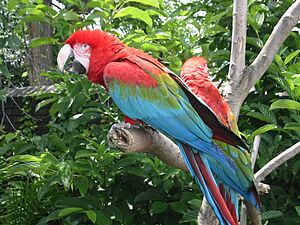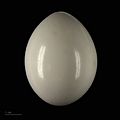Red-and-green macaw facts for kids
The red-and-green macaw (Ara chloropterus) is a very large, mostly red macaw found in the forests of South America. It's the biggest bird in the Ara group of macaws. These colorful birds often live in large groups of 30 or more in lowland areas. In forested mountains, they might form smaller groups of two or three pairs. At night, they sleep together in trees. During the day, they fly long distances to find their favorite foods: fruit and seeds. They also spend a lot of time resting and making loud noises, chatting with each other! Sadly, like other macaws, their numbers have gone down because their homes are being destroyed. They are also sometimes hunted for food or feathers, or illegally caught to be sold as pets.
Contents
About the Red-and-Green Macaw
The red-and-green macaw is one of the largest parrots in the world. It can grow to be about 90 to 95 centimeters (35 to 37 inches) long from its head to the tip of its tail. Most of its body is bright red, but it has green feathers on its wings and blue feathers on the tips of its wings and tail. It also has a patch of white skin around its eyes with small lines of red feathers. These lines are unique, like fingerprints!
Where They Live
Red-and-green macaws live in the northern and central parts of South America. You can find them in countries like Colombia, Venezuela, Brazil, Peru, and Bolivia. They prefer to live in tropical rainforests and woodlands, especially near rivers. They need tall trees for nesting and sleeping, and plenty of fruit trees for food.
What They Eat
These macaws are mostly herbivores, meaning they eat plants. Their diet mainly consists of various fruits, seeds, and nuts. They have very strong beaks that can easily crack open hard nuts, like those from palm trees. They also eat clay from riverbanks, which helps them digest their food and get important minerals.
Life Cycle and Behavior
Red-and-green macaws are very social birds. They often fly in pairs or small family groups, but they come together in larger flocks to roost (sleep) at night. They are known for being very noisy, making loud squawks and calls to communicate with each other.
Reproduction
Red-and-green macaws usually mate for life. They build their nests in holes in tall trees, often in dead palm trees. The female typically lays two to three eggs. Both parents take turns incubating the eggs, which means keeping them warm until they hatch. After the chicks hatch, both parents work together to feed and care for them until they are old enough to fly and leave the nest. This usually takes about three to four months. Young macaws stay with their parents for a while, learning how to find food and survive.
Why They Need Our Help
Sadly, the number of red-and-green macaws is decreasing. One of the biggest problems is habitat loss. The forests where they live are being cut down for farming, logging, and other human activities. This means macaws lose their homes and their food sources. They are also sometimes caught illegally to be sold as pets, which is a big problem for their populations in the wild. People are working to protect these beautiful birds and their homes so they can continue to fly free in the South American forests.
Images for kids
-
Four wild green-winged macaws flying in Peru
See also
 In Spanish: Guacamayo rojo para niños
In Spanish: Guacamayo rojo para niños





